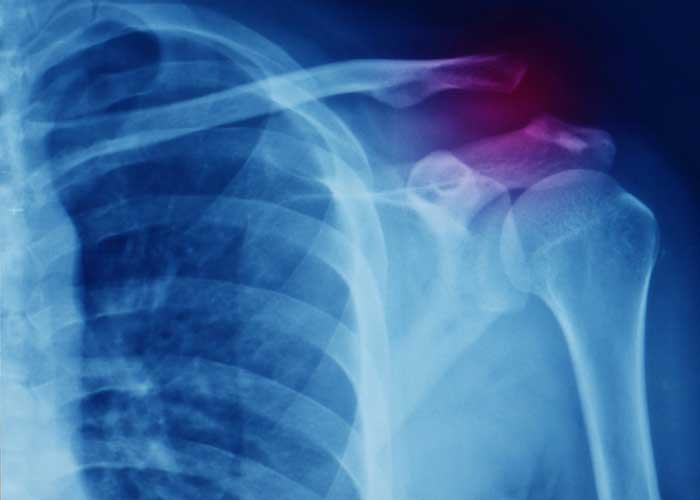AC Joint Injury Specialist

Are you an athlete who participates in contact sports? If so, you may be at risk of an AC joint injury to your shoulder. A separated shoulder is typically caused by blunt trauma to the shoulder or by a fall onto the shoulder. Separated shoulder specialist, Doctor Benedict Nwachukwu provides diagnosis as well as surgical and nonsurgical treatment options for patients in Manhattan, New York City, NY who have suffered a shoulder seperation. Contact Dr. Nwachukwu’s team today!
What is an AC joint injury?
The acromioclavicular (AC) joint is where the clavicle (collarbone) meets the acromion (highest point of the shoulder). The AC joint is one of the three joints that make up the shoulder capsule and is the most likely joint to suffer a separation. This type of AC joint injury occurs when the ligaments connecting the acromion and the clavicle are injured and the acromion moves away from the clavicle. A mild AC joint injury occurs when the ligaments of the joint stretch. Severe separations involve torn ligaments and are often caused by a hard fall, direct trauma or a blunt force, like a football tackle. Dr. Benedict Nwachukwu, orthopedic shoulder specialist can help patients in Manhattan, New York City and the surrounding New York boroughs who have experienced an AC joint injury. He has extensive experience successfully treating acromioclavicular joint separations and can help patients get back to work and the sporting activities they love.

Is an AC joint separation the same thing as a dislocated shoulder?
Shoulder separation (i.e. AC joint separation) and shoulder dislocation are two completely different injuries. The main difference is the location of the injury. An AC joint injury occurs between the clavicle and the acromion, and a dislocated shoulder occurs between the humerus (arm bone) and the glenoid (shoulder socket). Each injury can be serious, but a shoulder dislocation is (often) more traumatic. Shoulder dislocations need to be reduced (put back into place) and can be accompanied by torn ligaments, torn cartilage and other soft tissue damage. An AC joint separation can also be severe, especially if the two ligaments that help suspend the arm are torn. In traumatic events, both a separation and a dislocation can occur, but it is more likely for patients to experience an AC joint separation.
How are AC joint injuries classified?
AC joint injuries are separated into types, based on their severity:
- Type 1 and 2: Low-grade separation and is usually treated non-surgically with rest then physical therapy to strengthen the surrounding muscles
- Type 3: More severe AC joint separation which completely tears the two ligaments responsible for the joint’s stability. These ligaments are called the AC and CC ligaments.
- Type 4, 5 and 6: The most severe AC joint injury in which both the AC and CC ligaments are disrupted and require reconstructive shoulder surgery. These types of AC injuries are rare and cause extreme AC joint pain, shoulder instability and a visual deformity.
What are the symptoms of an AC injury?
An AC joint injury can vary from a mild sprain with no visual changes in the shoulder, to a severe separation that causes a visual deformity. Common symptoms include:
- Intense pain at the time of injury
- Bruising and swelling
- A visual bump or deformity on the top of the shoulder
- Joint pain that may vary from mild tenderness to intense pain
- Weakness
- Decreased range of motion
How is an AC joint injury diagnosed?
A separated shoulder can be easy to diagnose if it causes a visual deformity, however some severe AC separations may only be accompanied by pain and tenderness. If an AC joint injury is suspected, Dr. Nwachukwu will perform a physical examination to locate the area of discomfort and assess other possible damage. X-rays and an MRI scan may be used to determine the extent of the injury, as well as rule out fractures or other possible injuries.
How is an acromioclavicular joint injury treated?
Non-surgical treatment:
Lower grade AC joint injuries are usually treated non-surgically and will have a good outcome with full recovery. Treatments may include:
- Rest
- Ice
- Stabilization (a shoulder sling to help immobilize the joint while healing)
- Anti-inflammatory medication (NSAIDs)
- Physical therapy
Surgical Treatment Options
Dr. Nwachukwu may recommend surgical treatment for AC joint injuries that are type 3-6. Decision for surgery is made between the patient and doctor, with a discussion about the overall goals, activity level and expected outcome. Dr. Nwachukwu typically uses arthroscopic assisted AC joint stabilization surgery to repair the ligament damage within the shoulder.
If the ligaments have sustained severe damage, he may use a ligament graft and sutures to restore the stability of the joint. AC joint stabilization surgery is most effective when patients follow the post-surgical protocols given by Dr. Nwachukwu. Physical therapy will be required to restore the strength and range of motion for the joint and patients can typically expect to return to their normal activities within 3-6 months depending on the extent of the repair.

For more information on an AC joint injury or shoulder separation and the treatments available, please contact the office of Benedict Nwachukwu, MD, orthopedic shoulder specialist serving Manhattan, New York City and surrounding New York boroughs.